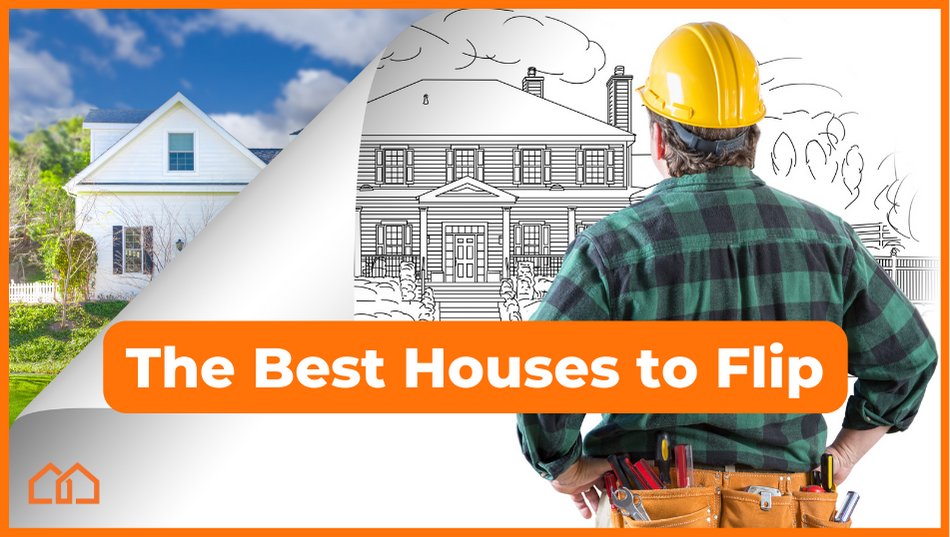What are the best houses to flip?
The best houses to flip are properties that, when sold, have an acceptable profit margin. House flippers, unlike buy-and-hold investors, are not interested in long-term rentals and ongoing renovations. They are in the business of flipping houses – or turning a less-than-perfect property into a restored home that can be sold for top dollar. It is a one-and-done real estate investment conducted for a lump sum profit.
What kinds of houses fit the ideal profile to become a flipped home? Today we will focus on what houses real estate investors should get if they plan to flip them.
This blog would not be complete without the expert contribution of Jon Wilson, Vice President of Marketplace Homes’ Property Management Department. Thank you, Jon, for taking the time to verify facts and add your insights!
Above All Else, Follow The 70% Rule.
Many house flippers follow “the 70% rule”, which gives a mathematical guideline to not overspend on a flip house. Overall, a flipper shouldn’t pay more than 70% of a house’s after-repair value (ARV- what the house can sell for after restoration) minus the cost of repairs. This is why most flips are usually discounted foreclosed homes.
So, if the house would be worth $200,000 after repairs, then you multiply that number by .7 to get $140,000. Then, you must deduct the cost of potential repairs to profit. Let’s say the house needs around $40k of work. You then subtract $40k from $140,000 to get $100,000 as the ideal price to buy the distressed property. If you plan to use a lender, you also need to figure in financing costs.
Knowing what you will pay to flip gives you the margin to invest in repairs and still get profit after setting a list price at total market value.
What Are The Best Houses To Flip?
The best houses to flip typically have a set of characteristics that enable investors to get top dollar. Here are some of the criteria:
#1: In a Good Location
Home flippers must be strategic about the property’s location. Local housing market conditions, the house’s subdivision, proximity to amenities, and positioning near busy roads all matter. A house located near desirable amenities while not being right next to a busy road is more appealing than a rural house right off a busy high-speed road.
Noise is also a factor tied closely to location. Houses right next to the highway or train tracks face a discount for the louder noises experienced daily. Since you can’t just move a house to a better location, choose your investment property wisely with a future homeowner in mind.
#2: Has Reasonable Remodeling Costs
The ideal flip house will need some work but not so much that it makes it nearly impossible to make a profit after renovations. For instance, a house that needs a fresh coat of interior paint, new flooring, and updated appliances allows an opportunity for profit. At the same time, a house with major structural or mold issues can be too expensive to flip.
This is why due diligence is important, and to get an inspection whenever possible. In the cases when an inspection isn’t allowed due to auction laws, then it’s safe to assume that every room in the house needs some work and to make your bids accordingly.
Typically, flippers get the best deal when they only have to deal with some cosmetic details like paint and flooring. It is also okay to get a house that needs a new roof, because that is a common barrier to a home being on the open market. An outdated home with good bones while being in a good location and the market is the key.
#3: It’s Close to Amenities
Each real estate market has its ideal high-demand residential property. For some communities, like a densely populated urban area, an apartment near public transit would be the hot commodity. In other areas, a single-family rental near shopping, healthcare, and restaurants would be the best flip properties. Being near the right amenities for the market matters. Overall, being near more services and goods raises or stabilizes a property’s value. It’s stronger protection for a home, its after-repair value, and its purchase price compared to a home in the middle of nowhere.
#4: Is An Average Size And Price
In every market, there is an average income and home size. The ideal flip fits the average home people in the local market tend to buy. Therefore, you need to find out what homes are selling and what is sitting on the market. If the average fast-selling house is around 1500 square feet, then that is a safer flip than a 4000 square foot house that may be harder to sell.
Also, if a home ends up being too expensive for the local buyer after you flip it, it can end up sitting on the market or require a price reduction. Choosing the right price and size from the beginning eliminates this nuisance.
#5: Has Potential For a “One Up” Upgrade
If your house fits within the average desirable property metrics, adding something extra that isn’t too costly can work in your favor. For instance, if most houses in the neighborhood don’t have a fenced backyard, adding a fence can make it unique and preferred over a competitor next door.
Or, you may do a minor kitchen remodel in a neighborhood where comps have old kitchens. Landscaping is also typically an affordable improvement that adds a lot of curb appeal. “One Ups” like these can make your listing immediately stand out without spending too much.
#6: The Numbers Work in Your Favor
House flippers need not worry about cap rate or cash flow, but they do need to worry about exceeding their rehab budget. Going overboard will cost you. The financial rule for house flipping is to not exceed 65-70% of the home’s after-repair value, less the cost of renovating the property. Having a realtor do a comparative market analysis of your home’s ARV will allow you to determine if there is potential to profit.
If you plan to use a short-term hard money loan to buy your investment, check out fine print terms like closing costs and monthly payments that will add to the total cost. Real estate agent commissions also need to come into play.
This is why the ideal flip investment strategy often includes foreclosures, short sales, or auctions in which the home is not fully neglected but not insanely updated either. Work with a realtor to understand the average home prices of like properties and make the numbers work with their prospective home value.
#7 Be Smart & Meet Market Expectations
When flipping a house, make sure you do the improvements to meet buyer expectations. This changes in different markets, but when you plan to sell on the open market, the house must be in a condition that attracts buyer confidence.
“Right now, buyers are not looking for a project. After paying more for a house, they want a house that is worth the cost. Today’s buyers consider a big ticket improvement a huge selling point because it means they won’t have to spend money on it themselves,” says Jon.
If you have the budget to do it, make the big improvements and advertise with “new roof” of “new hvac” to cater today’s buyers. The more big ticket items you take away from the buyer’s plate, the better.
The Best Houses to Flip
A lot of things need to be in line for a house to be an ideal flip project. If it isn’t a good flip, it can be a good rental property that you can allow to grow in value and market value as time elapses. This is why there is no single property solution, and Marketplace Homes has so many different solutions for investors and new construction homebuyers.
Whether you need to find houses to flip or find a fixer-upper for a primary residence, our team of real estate pros can help you set the right sale price, position yourself for a favorable return on investment, and help you find the best cities and markets for your next investment. We help everyone from beginners to seasoned institutional investors, so call us today.
Summary: This article discusses what makes a house a good property to flip for a one-time profit. Factors like the 70% rule and marketability have a lot of influence in whether a house can be profitable to a real estate investor.
Alicia Persson is a Content Strategist SEO writer at Marketplace Homes, utilizing previous years of experience on real estate teams that specialized in investments and property management. Before she joined Marketplace Homes, she was also a freelance writer for 7 years, leading to a specialization in real estate and home living content for boutique digital marketing agencies. During her writing years, she learned the basics of SEO and gained experience writing for many different clients, making her versatile at creating diverse content.
She is a proud University of Virginia master’s graduate and enjoyed her undergraduate years at the University of Mary Washington. When Alicia is not writing, she plays keytar and sings in a local 90’s rock cover band, or she spends time with her amazing family.

